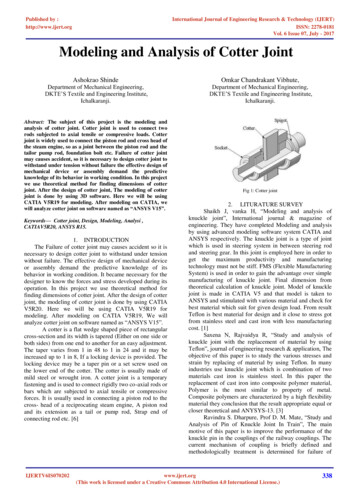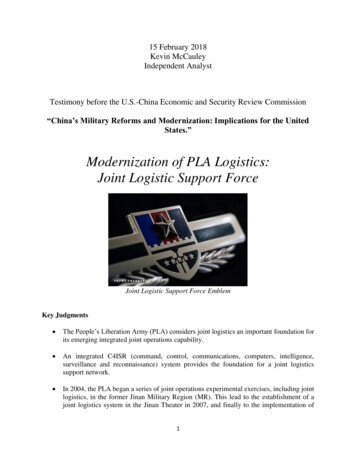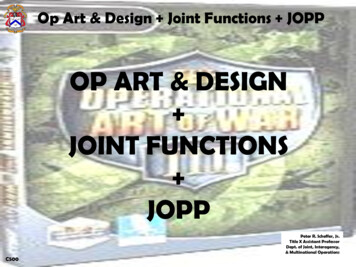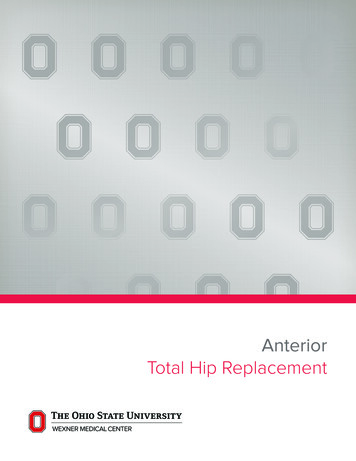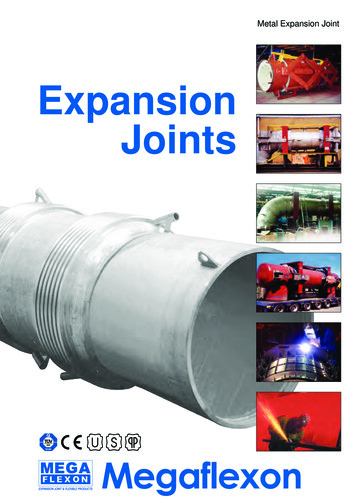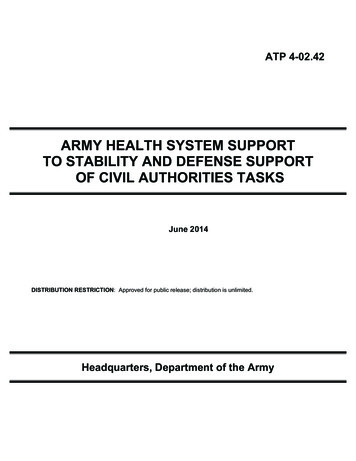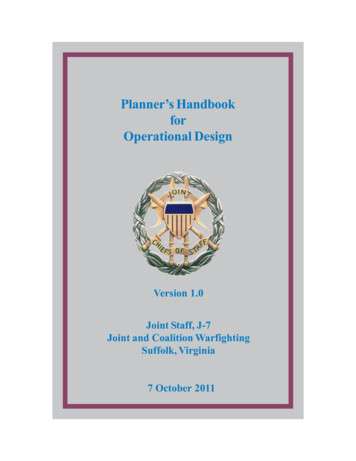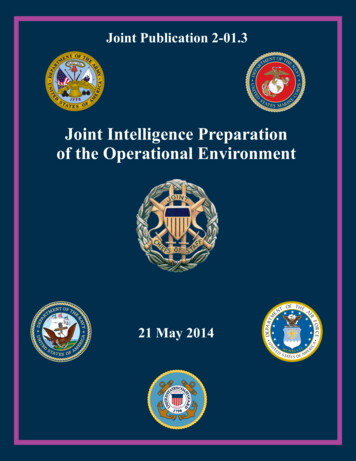
Transcription
ENHITTMT OF T HS W E' L LDEFEENDARDSTMTEERU NII CA MY DE PARJoint Publication 2-01.3AT E S O FAJoint Intelligence Preparationof the Operational Environment21 May 2014
PREFACE1. ScopeThis publication provides doctrine for conducting joint intelligence preparation ofthe operational environment (OE) across the range of military operations. It describes theprocess to analyze the adversary and other relevant aspects of the OE in order to identifypossible courses of action and to support joint operation planning, execution,and assessment.2. PurposeThis publication has been prepared under the direction of the Chairman of the JointChiefs of Staff (CJCS). It sets forth joint doctrine to govern the activities andperformance of the Armed Forces of the United States in joint operations and providesthe doctrinal basis for interagency coordination and for US military involvement inmultinational operations. It provides military guidance for the exercise of authority bycombatant commanders and other joint force commanders (JFCs) and prescribes jointdoctrine for operations, education, and training. It provides military guidance for use bythe Armed Forces in preparing their appropriate plans. It is not the intent of thispublication to restrict the authority of the JFC from organizing the force and executingthe mission in a manner the JFC deems most appropriate to ensure unity of effort in theaccomplishment of the overall objective.3. Applicationa. Joint doctrine established in this publication applies to the joint staff, commandersof combatant commands, subunified commands, joint task forces, subordinatecomponents of these commands, the Services, and combat support agencies.b. The guidance in this publication is authoritative; as such, this doctrine will befollowed except when, in the judgment of the commander, exceptional circumstancesdictate otherwise. If conflicts arise between the contents of this publication and thecontents of Service publications, this publication will take precedence unless the CJCS,normally in coordination with the other members of the Joint Chiefs of Staff, hasprovided more current and specific guidance. Commanders of forces operating as part ofa multinational (alliance or coalition) military command should follow multinationali
Prefacedoctrine and procedures ratified by the United States. For doctrine and procedures notratified by the United States, commanders should evaluate and follow the multinationalcommand’s doctrine and procedures, where applicable and consistent with US law,regulations, and doctrine.For the Chairman of the Joint Chiefs of Staff:DAVID L. GOLDFEIN, Lt Gen, USAFDirector, Joint StaffiiJP 2-01.3
SUMMARY OF CHANGESREVISION OF JOINT PUBLICATION 2-01.3DATED 16 JUNE 2009 Explains the reallocation of responsibility for the coordination and tasking ofintelligence production support for current and planned joint operations tothe Joint Staff Directorate for Intelligence and the Defense IntelligenceAgency due to the disestablishment of the Defense Intelligence OperationsCoordination Center. Describes the roles and contributions of the National Geospatial-IntelligenceAgency, National Security Agency/Central Security Service, Defense ThreatReduction Agency, and the Joint Improvised Explosive Device DefeatOrganization, to the joint intelligence preparation of the operationalenvironment (JIPOE) process. Provides a more holistic description of the main focus of the JIPOE. Establishes separate chapters for discussing each of the four steps in theJIPOE process. Explains the intelligence implications for the growing recognition of theimportance of “other relevant actors” to joint operations, to include a newappendix with an Operation IRAQI FREEDOM case study. More clearly explains the JIPOE functions of a combatant command jointintelligence operations center. Identifies additional members for a notional joint force “JIPOE coordinationcell.” Clarifies the roles and responsibilities between a “red cell” and the“combatant command red team” within the JIPOE process. Expands the discussion of cyberspace considerations. Provides a new discussion of identity intelligence products and socioculturalanalysis contributions to JIPOE. Describes the capabilities and contributions of weapons technical intelligenceto the intelligence directorate of a joint staff planning and JIPOE. Modifies the joint definitions of “exploitation,” “military geography,” and“named area of interest.”iii
Summary of ChangesIntentionally BlankivJP 2-01.3
TABLE OF CONTENTSPAGEEXECUTIVE SUMMARY . xiCHAPTER IAN OVERVIEW OF JOINT INTELLIGENCE PREPARATION OF THEOPERATIONAL ENVIRONMENT Introduction . I-1The Operational Environment—A Holistic View . I-2Differences Between Joint Intelligence Preparation of the OperationalEnvironment and Intelligence Preparation of the Battlespace . I-5Joint Intelligence Preparation of the Operational Environment and theJoint Intelligence Process . I-5Organizations, Roles, and Responsibilities. I-9Interagency and Multinational Considerations . I-18Relationship to the Levels of Warfare . I-19Considerations Across the Range of Military Operations . I-22Overview of the Process for Joint Intelligence Preparation of the OperationalEnvironment . I-24CHAPTER IIDEFINE THE OPERATIONAL ENVIRONMENT—STEP 1 Overview .II-1Identify the Joint Force’s Operational Area.II-2Analyze the Mission and Joint Force Commander’s Intent .II-3Determine the Significant Characteristics of the Operational Environment .II-3Identify the Limits of the Joint Force’s Area of Interest .II-5Determine the Level of Detail Required and Feasible Within the Time Available .II-6Determine Intelligence and Information Priorities, Gaps, and Shortfalls .II-7Collect Material and Submit Requests for Information to Support FurtherAnalysis.II-7CHAPTER IIIDESCRIBE THE IMPACT OF THE OPERATIONAL ENVIRONMENT—STEP 2 Overview . III-1Develop a Geospatial Perspective of the Operational Environment . III-2Develop a Systems Perspective of the Operational Environment . III-33Describe the Impact of the Operational Environment on Adversary andFriendly Capabilities . III-48v
Table of ContentsCHAPTER IVEVALUATE THE ADVERSARY AND OTHER RELEVANT ACTORS—STEP 3 Overview . IV-1Update or Create Adversary and Other Relevant Actors Models . IV-2Determine the Current Adversary and Other Relevant Actor Situations . IV-8Identify Adversary and Other Relevant Actor Centers of Gravityand Decisive Points . IV-10Identify Adversary and Relevant Actors’ Capabilities and Vulnerabilities. IV-14CHAPTER VDETERMINE ADVERSARY AND OTHER RELEVANT ACTORCOURSES OF ACTION—STEP 4 Overview . V-1Identify the Adversary’s and Other Relevant Actors’ Strategy,Likely Objectives, and Desired End State . V-2Identify the Full Set of Adversary and Other Relevant Actor Courses of Action . V-2Evaluate and Prioritize Each Course of Action . V-4Develop Each Course of Action in the Amount of Detail that Time Allows . V-5Identify Initial Collection Requirements . V-8CHAPTER VISUPPORT TO JOINT OPERATION PLANNING, EXECUTION, ANDASSESSMENT Introduction . VI-1Section A. Planning Overview . VI-1 Planning Initiation . VI-3 Mission Analysis . VI-5 Course of Action Development . VI-5 Course of Action Analysis and Wargaming . VI-6 Course of Action Comparison . VI-9 Course of Action Approval . VI-10 Plan or Order Development . VI-10Section B. Execution Overview . VI-12 Shape Phase . VI-13 Deter Phase . VI-14 Seize Initiative Phase . VI-14 Dominate Phase . VI-15 Stabilize Phase . VI-16 Enable Civil Authority Phase. VI-16viJP 2-01.3
Table of ContentsSection C. Assessment Overview . VI-16 Assessment Process . VI-17 Support to Assessing Performance . VI-18 Support to Assessing Effectiveness . VI-19CHAPTER VIISPECIAL CONSIDERATIONS Introduction . VII-1Section A. Support During Irregular Warfare Overview . VII-1 Sociocultural Factors . VII-2 Infrastructure Analysis . VII-8 Emphasis on Detailed Knowledge . VII-9 Collaboration and Information Sharing . VII-12 Focused Process and Tailored Products . VII-12Section B. Countering Asymmetric Approaches Overview . VII-15 Adversary Measures to Avoid Detection . VII-15 Adversary Exploitation of the Information Environment . VII-19 Terrorism. VII-21 Insurgency . VII-23 Chemical, Biological, Radiological, and Nuclear Threats and Hazards . VII-25 Missiles and Precision Munitions . VII-28Section C. Support to Domestic Operations Special Circumstances in the United States . VII-30APPENDIXABCDEFGThe Leyte Campaign—A Case Study of Support toMajor Operations and Campaigns . A-1Somalia 1992-1993—A Case Study of Support toStability Operations and Irregular Warfare .B-1Operation IRAQI FREEDOM—A Case Study in DeterminingRelevant Actor Courses of Action.C-1Analyzing and Depicting a System . D-1Joint Intelligence Preparation of theOperational Environment Specialized Products . E-1References . F-1Administrative Instructions . G-1vii
Table of ContentsGLOSSARYPart IPart IIAbbreviations and Acronyms . GL-1Terms and Definitions . 5IV-6IV-7IV-8viiiHolistic View of the Operational Environment . I-3A Synergistic Integration of Perspectives . I-6The Intelligence Process . I-7Joint Intelligence Preparation of the Operational Environment and theIntelligence Estimate . I-8Joint Intelligence Preparation of the Operational EnvironmentCoordination Cell . I-14Joint Intelligence Preparation of the Operational Environment—The Process . I-25Joint Intelligence Preparation of the Operational Environment—Step 1 .II-2Joint Intelligence Preparation of the Operational Environment—Step 2 . III-1Constructing a Combined Obstacle Overlay . III-5Mobility Corridors Grouped to Form Avenues of Approach . III-7Land Modified Combined Obstacle Overlay . III-9Maritime Modified Combined Obstacle Overlay. III-13Air Modified Combined Obstacle Overlay . III-17Space Modified Combined Obstacle Overlay . III-20Impact of the Information Environment on Military Operations . III-21Combined Information Overlay . III-24Information System Vulnerability Assessment Matrix . III-25Electromagnetic Modified Combined Obstacle Overlay . III-28Potential Interference Chart. III-29Effects of Weather on Military Operations . III-32Systems Perspective of the Operational Environment . III-34Systems Nodes and Links . III-41The Breadth and Depth of a Systems Perspective. III-43Example of a Network Analysis Diagram . III-45Measures of Node Centrality. III-47Joint Intelligence Preparation of the Operational Environment—Step 3 . IV-1Ground and Air Adversary Template . IV-3Naval Adversary Template. IV-4Systems Perspective Adversary Template . IV-5Time Event Matrix . IV-7Target Value Matrix . IV-9Characteristics of Center of Gravity. IV-11Analyzing Critical Factors . IV-13JP 2-01.3
Table of 4B-15B-16B-17Joint Intelligence Preparation of the Operational Environment—Step 4 . V-1Constructing a Situation Template . V-6Geospatial Situation Template . V-8Systems Situation Template . V-9Situation Matrix. V-10Constructing an Event Template . V-11Event Template . V-12Constructing and Event Matrix . V-13Event Matrix . V-14Joint Operation Planning . VI-2Decision Support Template . VI-8Intelligence Synchronization Matrix . VI-11Support to Joint Operation Execution . VI-12Assessment Levels and Measures . VI-17Mapping Human Factors .VII-10Support to Countering Asymmetric Approaches .VII-16Pacific Theater Situation September 1944 . A-1Modified Combined Obstacle Overlay for Philippines . A-4Modified Combined Obstacle Overlay for Leyte . A-5Japanese Force Situation October 1944 . A-7Situation Template for Course of Action 1 (Defense of Leyte) . A-8Situation Template for Course of Action 2 (Reinforcement of Leyte) . A-9Situation Template for Course of Action 3 (Decisive Attack) . A-10Situation Template for Course of Action 4 (Withdrawal from Leyte) . A-11Japanese Courses of Action Matrix . A-12Leyte Event Template . A-13Leyte Event Matrix. A-14Leyte Gulf Situation October 1944 . A-15Internally Displaced Persons Camp Locations.B-3Southern Somalia Road Infrastructure .B-5Mogadishu Port .B-6Airfields and Ports .B-8Somalia Seasons .B-9Somali Clan Structure .B-11Consolidated Systems Overlay.B-12Somali Warring Factions .B-13Systems Perspective Adversary/Relevant Actor Template .B-15Map of Mogadishu .B-16Mogadishu Land Use Overlay.B-17Mogadishu Faction Control Overlay .B-18Mogadishu Transportation Overlay .B-19Mogadishu Information Environment Overlay .B-20Mogadishu International Presence Overlay .B-21Center of Gravity Analysis .B-22Adversary/Relevant Actor Potential Courses of Action .B-23ix
Table of -8E-9E-10E-11E-12xSystems Situation Template for Course of Action 1—Militias Acquiesce .B-25Systems Situation Template for Course of Action 2—Some Militias Oppose .B-26Systems Situation Template for Course of Action 3—Widespread Civil War .B-27Systems Situation Template for Course of Action 4—Islamic Violent Extremism.B-28Systems Event Template .B-29Event Matrix .B-30Systems Network Analysis Diagram.B-31Distribution of Ethnoreligious Groups and Major Tribes .C-2Narcotics Network Analysis—1. D-2Narcotics Network Analysis—2. D-3Narcotics Network Analysis—3. D-4Narcotics Network Analysis—4. D-5Narcotics Network Analysis—5. D-7Narcotics Network Analysis—6. D-8Political Subsystems . D-10Military Subsystems . D-11Economic Subsystems . D-12Social Subsystems . D-13Infrastructure Subsystems . D-14Information Subsystems . D-15Infrastructure Overlay . E-1Primary and Secondary Route Overlay . E-2Pattern Analysis Plot Sheet . E-3Quarantine Overlay . E-4Population Support Overlay . E-5Legal Status Overlay . E-6Ethnicity Overlay . E-7Perceptions Assessment Matrix . E-8Activities Matrix . E-9Association Matrix . E-10Link Diagram . E-11Biometric Focused Area Studies . E-12JP 2-01.3
EXECUTIVE SUMMARYCOMMANDER’S OVERVIEW Provides an overview of joint intelligence preparation of the operationalenvironment (JIPOE) assessments, estimates, and other intelligenceproducts. Explains how JIPOE defines the operational environment (OE) byidentifying aspects and significant characteristics that may be relevant to thejoint force’s mission. Describes how a systems perspective is developed to analyze the impact of theOE on adversary, friendly, and neutral military capabilities. Describes how the JIPOE process identifies and evaluates adversarycapabilities and limitations, current situation, center of gravity, andadversary forces’ doctrine, patterns of operation, and tactics, techniques, andprocedures. Explains how the JIPOE process develops a detailed understanding ofadversary and other relevant actors’ probable intent and future strategy. Describes JIPOE support to joint operation planning, execution, andassessment Outlines JIPOE support during irregular warfare, particularly to counterasymmetric approaches. Provides an overview of the parameters under which Department of Defenseintelligence components operate when supporting domestic operations.An Overview of Joint Intelligence Preparation of theOperational EnvironmentThe OperationalEnvironment (OE)—A Holistic ViewThe operational environment (OE) is a composite of theconditions, circumstances, and influences that affect theemployment of capabilities and bear on the decisions ofthe commander. The joint intelligence preparation ofthe operational environment (JIPOE) process is used toanalyze all relevant aspects of this environment,including the adversary and other actors; the physicaldomains (air, land, maritime, and space); theinformation environment (which includes cyberspace);xi
Executive Summaryand political, military, economic, social, information,and infrastructure (PMESII) systems and subsystems.A holistic understanding of all relevant componentswithin the OE helps the joint force commander (JFC) toknow how the OE constrains or shapes options, how theOE affects capabilities, and how friendly, adversary,and neutral actors’ actions affect or shape the conflict.Of greatest significance, understanding relevant aspectsof the OE enables the JFC to leverage aspects of the OEto achieve the objectives and attain the desired endstates of the operation.The JIPOE process provides a disciplined methodologyfor applying a holistic view of the OE to the analysis ofadversary capabilities and intentions. This processconsists of four basic steps: define the operationalenvironment, describe the impact of the operationalenvironment, evaluate the adversary and other relevantactors, and determine adversary and other relevant actorcourses of action (COAs). These four steps ensure thesystematic analysis of all relevant aspects of the OE.The process is both continuous and cyclical in thatJIPOE is conducted both prior to and during a jointoperation as well as during planning for follow-onmissions. The most current information availableregarding the adversary situation and the OE iscontinuously integrated throughout the JIPOE process.Although some aspects of the JIPOE process mayrequire adjustment depending on the type of mission,the basic process remains the same throughout therange of military operations.Define the Operational Environment—Step 1In the first step of the JIPOE process, the joint forcestaff assists the JFC and component commanders indef
intelligence production support for current and planned joint operations to the Joint Staff Directorate for Intelligence and the Defense Intelligence Agency due to the disestablishment of the Defense Intelligence Operations Coordination Center. Describes the roles and contributions of the National Geospatial-Intelligence


